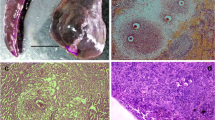Abstract
SCHISTOSOMIASIS (bilharzia) is a parasitic disease caused by several species of schistosome worms (blood flukes). The key pathogenic event in this disease is the formation of granulomas around schistosome eggs trapped in portal venules of the liver1–9. Granulomas are a distinctive form of chronic inflammation characterized by localized aggregation of activated macrophages around an inciting stimulus10. Each granuloma evolves to form a fibrous scar; in schistosomiasis, the result is widespread hepatic fibrosis and portal hypertension. To identify the specific immune signal molecules necessary for granuloma formation, we studied schistosome infections in severe combined immunodeficient (SCID) mice, which have normal macrophages but lack functional B or T lymphocytes11,12. Here we report that the immunoregulatory cytokine tumour necrosis factor α is necessary and sufficient to reconstitute granuloma formation in schistosome-infected SCID mice. Moreover, we find that the parasitic worms require tumour necrosis factor α for egg-laying and for excretion of eggs from the host. The implication of this latter result is that the parasite has adapted so successfully to its host that it uses a host-derived immuno-regulatory protein as a signal for replication and transmission.
Similar content being viewed by others
References
Warren, K. S., Domingo, E. O. & Cowan, R. B. T. Am. J. Path. 51, 735–756 (1967).
Phillips, S. M. & Colley, D. G. Prog. Allergy 24, 49–182 (1978).
Doughty, B. L. & Phillips, S. M. J. Immun. 128, 37–42 (1982).
Prakash, S., Postlethwaite, A. E., Stricklin, G. P. & Wyler, D. J. J. Immun. 144, 317–322 (1990).
Olds, G. R. & Kresina, T. F. J. infect. Dis. 159, 798–801 (1989).
Byram, J. E. & von Lichtenberg, F. Am. J. trop. Med. Hyg. 26, 944–955 (1977).
Cheever, A. W., Byram, J. E. & von Lichtenberg, F. Parasite Immun. 7, 387–398 (1985).
Cheever, A. W., Deb, S. & Duvall, R. H. Am. J. trop. Med. Hyg. 40, 66–71 (1989).
Mathew, R. C. & Boros, D. L. Infect. Immunity. 54, 820–826 (1986).
Robbins, S. L., Cotran, R. S. & Kumar, V. Pathologic Basis of Disease 64–65 (Saunders, Philadelphia, 1984).
Bosma, G. C., Custer, R. P. & Bosma, M. J. Nature 301, 527–530 (1983).
Custer, R. P., Bosma, G. C. & Bosma, M. J. Am. J. Path. 120, 464–477 (1985).
Pearce, E. J., Caspar, P., Grzych, J. M., Lewis, F. A. & Sher, A. J. exp. Med. 173, 159–166 (1991).
Grzych, J. M. et al. Immun. 146, 1322–1327 (1991).
McGee, H. J., Long, S. R. & Briggs, W. R. Nature 308, 667–668 (1984).
Kaye, J. & Janeway, C. A. J. exp. Med. 159, 1397–1412 (1984).
Chensue, S. W., Otterness, I. G., Higashi, G. I., Forsch, C. S. & Kunkel, S. L. J. Immun. 142, 1281–1286 (1989).
Kindler, V., Sappino, A.-P., Grau, G. E., Piguet, P.-F. & Vassalli, P. Cell 56, 731–740 (1989).
Jäätelä, M. Lab. Invest. 64, 724–742 (1991).
Piguet, P. F., Collart, M. A., Grau, G. E., Sappino, A.-P. & Vassalli, P. Nature 344, 245–247 (1990).
Byram, J. E., Doenhoff, M. J., Musallam, R., Brink, L. H. & von Lichtenberg, F. Am. J. trop. Med. Hyg. 28, 274–285 (1979).
Doenhoff, M. J., Dunne, D. W., Bain, J., Lillywhite, J. E. & McLaren, M. L. Devl. Biol. Standard. 62, 63–73 (1985).
Perrin, P. J. & Phillips, S. M. J. Immun. 141, 1714–1719 (1988).
Doenhoff, M. J., Hassounah, O. & Murare, H. Trans. R. Soc. trop. Med. Hyg. 80, 503–514 (1986).
Duvall, R. H. & DeWitt, W. B. Am. J. trop. Med. Hyg. 16, 483–486 (1967).
Cheever, A. W., Deb, S. & Duvall, R. H. Am. J. trop. Med. Hyg. 40, 66–71 (1989).
Basch, P. F. J. Parasit. 67, 179–185 (1981).
Author information
Authors and Affiliations
Rights and permissions
About this article
Cite this article
Amiri, P., Locksley, R., Parslow, T. et al. Tumour necrosis factor α restores granulomas and induces parasite egg-laying in schistosome-infected SCID mice. Nature 356, 604–607 (1992). https://doi.org/10.1038/356604a0
Received:
Accepted:
Issue Date:
DOI: https://doi.org/10.1038/356604a0
- Springer Nature Limited
This article is cited by
-
Variants of the CASP9 gene as candidate markers for primary response to anti-TNF therapy in Crohn’s disease patients
Journal of Applied Genetics (2023)
-
Human tumor necrosis factor alpha affects the egg-laying dynamics and glucose metabolism of Schistosoma mansoni adult worms in vitro
Parasites & Vectors (2022)
-
Dandelion (Taraxacum officinale) Improves the Therapeutic Efficiency of Praziquantel in Experimental Schistosomiasis
Acta Parasitologica (2022)
-
The evolution of TNF signaling in platyhelminths suggests the cooptation of TNF receptor in the host-parasite interplay
Parasites & Vectors (2020)
-
Differential responses of epithelial cells from urinary and biliary tract to eggs of Schistosoma haematobium and S. mansoni
Scientific Reports (2019)





